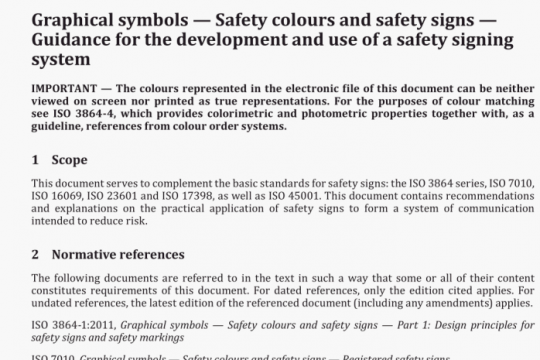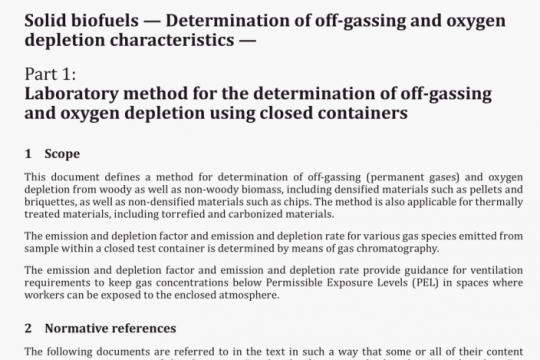ISO/TR 23173 pdf free download
ISO/TR 23173-2021 pdf free download.Surface chemical analysis – Electron spectroscopies一Measurement of the thickness and composition of nanoparticle coatings.
6 X-ray photoelectron spectroscopy
6.1 General
xPs provides quantitative information of the surface composition of a sample by the collection of photoelectrons emitted under exposure to an x-ray beam. The information depth of XPS is limited by the attenuation of the electrons through the sample, which itself is determined by both the properties of the sample material, and the kinetic energy of the emitted electrons. Lab-based instruments typically use either aluminium or magnesium Ka x-rays at a photon energy of 1 486,6 eV or 1 253,6 eV, respectively, this corresponds to a maximum information depth for the elastic photoelectron peaks of approximately 10 nm. More recently, lab-based instruments with higher energy X-ray sources have also been developed, with correspondingly larger information depths due to the higher kinetic energies of the photoelectrons.
Due to this high surface sensitivity, XPS is an inherently nanoscale technique in terms of depth of analysis and is thus suited to the analysis and characterisation of nano-objects. It is commonly used to provide quantitative information on the relative concentrations of elements within the surface of a sample under the assumption ofhomogeneity, however with a proper understanding ofthe underlying theory and appropriate methodology, greater information on the surface structure of samples can be extracted.
In most lab-based XPS instruments, the analysis area under standard operating conditions is on the order of 0,01 mm2 to 1 mm2 with some instruments possessing lens-based area-limiting or micro- focussed x-ray beams that allow analysis areas down to iO mm2 thus for samples of nanomaterials Xps typically serves as a population measurement technique, where the measured intensities are an average ofthe material within the analysis area.
Given the high surface sensitivity of XPS, it is also of crucial importance that samples be prepared, handled, and cleaned with appropriate procedures. The presence of contaminants within a sample can drastically influence the results of any measurements made. This is of especial importance for nanomaterial samples, which may often require more careful preparation, or be susceptible to additional sources of contamination. ISO 20579-4 discusses the issues relating to the handling of nanoobjects prior to surface analysisi12].
6.2 Coating thickness measurement
For flat, uniform surfaces measurement of overlayer thickness using XPS has been understood for some time. A formula for the calculation of oxide overlayer thicknesses was developed in the 1970sL1-41. More recently, ISO 14701Fll,dealing with the measurement of silicon oxide thickness using XPS, has been published. For reporting on measurements of overlayer thicknesses using XPS, ISO 13424L’-] describes the information to be included. For cases where the overlayer and substrate peaks to be quantified are not of similar kinetic energy, a graphical method known as the “Thickogram”[12] was developed. In any calculation of an overlayer thickness, it is necessary that the peak areas corresponding to the overlayer and substrate materials are identifiable and measurable.
For samples which are not flat, such methods will be in error due to the effects of sample geometry on the path-length of electrons through the overlayer. Under the assumption of a uniform overlayer thickness, a sample with a flat surface oriented for normal emission to the detector presents the shortest possible direct path for electrons through the overlayer. For a conformal, uniform overlayer any topography therefore increases this path length, in a manner equivalent to tilting the sample. Analytical methods to determine the “effective average tilt” of the sample which results from the topographylla] have been developed if the topography is either known or can be measured, for example by atomic force microscopy (AFM). For generic morphologies such as spheres and cylinders, a simpler method using the concept of “topofactors” has been shownl19]. In methods of this type, a calculation is made treating the sample as if flat, and then the relevant “topofactor” is applied to correct for the known topographyil9H2-1l.
Such methods for measurement of overlayers on topographic samples apply only in the case where the topography is on the macroscopic scale — that is, they cannot account for topography on the scale of the electron IMFP’s within the material. At this length scale the volumetric contribution of the coating to the XPS data becomes significant and the assumption of a continuous underlying substrate becomes invalid. For nanoparticle samples, the presence of overlayer material on the sides and underside of the particles, and potentially even particles beneath the outermost layer, can contribute to the measurement result.
6,3 Nanoparticle coating thickness
Several methods for the determination of nanoparticle coating thicknesses from XPS data are available. These can broadly be categorised into three types: simple numerical modelling, empirically determined formulae and the use of more rigorous simulation software. When any analysis of XPS data from nanoparticles is considered however, there are several assumptions which are typically made. Hereafter, particles conforming to these assumptions are described as “ideal” core-shell particles.
— The analysis area is assumed to be representative of the whole sample, exhibiting no macroscopic variation. In situations where this is not the case, multiple non-overlapping analysis areas can be used to assess the effect of any variation.
— Unless specifically accounted for, the nanoparticles are assumed to be randomly deposited, with no large-scale ordering[22l. This assumption is not necessary if the analysis method requires, or is capable of modelling, particles in a specific distribution.
— All of the measured XPS peak intensities are assumed to arise from the nanoparticles, with no significant contribution from the substrate or contaminantsL.1.].
— The core material and coating are each assumed to be uniform in density, i.e. possess no gaps, density gradients, or similar. It follows from this assumption that the boundary between the core and coating materials is abrupt, with no mixing layer.
— The core and coating are assumed to form a pair of concentric spheres.
— All the particles in the analysed population are identical in both chemical and physical structure.ISO/TR 23173 pdf download.




